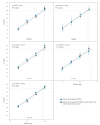Novel real-time PCR-based patho- and phylotyping of potentially zoonotic avian influenza A subtype H5 viruses at risk of incursion into Europe in 2017
- PMID: 28084214
- PMCID: PMC5388100
- DOI: 10.2807/1560-7917.ES.2017.22.1.30435
Novel real-time PCR-based patho- and phylotyping of potentially zoonotic avian influenza A subtype H5 viruses at risk of incursion into Europe in 2017
Abstract
Since November 2016, Europe witnesses another wave of incursion of highly pathogenic avian influenza (HPAI) A(H5) viruses of the Asian origin goose/Guangdong (gs/GD) lineage. Infections with H5 viruses of clade 2.3.4.4b affect wild bird and poultry populations. H5 viruses of clades 2.2, 2.3.1.2c and 2.3.4.4a were detected previously in Europe in 2006, 2010 and 2014. Clades 2.2.1.2 and 2.3.2.1.c are endemic in Egypt and Western Africa, respectively and have caused human fatalities. Evidence exists of their co-circulation in the Middle East. Subtype H5 viruses of low pathogenicity (LPAI) are endemic in migratory wild bird populations. They potentially mutate into highly pathogenic phenotypes following transmission into poultry holdings. However, to date only the gs/GD H5 lineage had an impact on human health. Rapid and specific diagnosis marks the cornerstone for control and eradication of HPAI virus incursions. We present the development and validation of five real-time RT-PCR assays (RT-qPCR) that allow sequencing-independent pathotype and clade-specific distinction of major gs/GD HPAI H5 virus clades and of Eurasian LPAI viruses currently circulating. Together with an influenza A virus-generic RT-qPCR, the assays significantly speed up time-to-diagnosis and reduce reaction times in a OneHealth approach of curbing the spread of gs/GD HPAI viruses.
Conflict of interest statement
Figures


References
MeSH terms
Substances
LinkOut - more resources
Full Text Sources
Other Literature Sources
Medical

